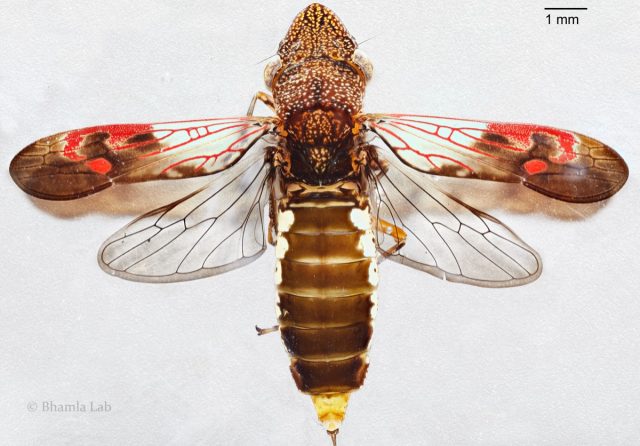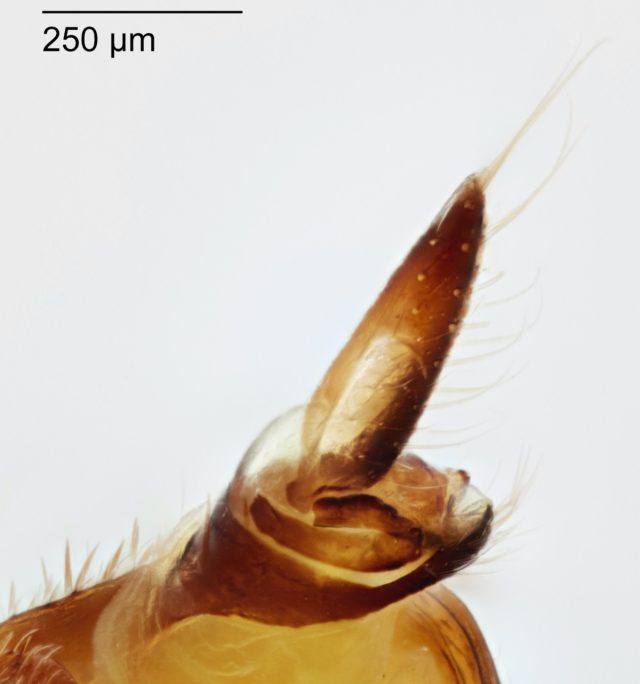The glassy-winged sharpshooter drinks huge amounts of water and thus pees frequently, expelling as much as 300 times its own body weight in urine every day. Rather than producing a steady stream of urine, sharpshooters form drops of urine at the anus and then catapult those drops away from their bodies at remarkable speeds, boasting accelerations 10 times faster than a Lamborghini. Georgia Tech scientists have determined that the insect uses this unusual "superpropulsion" mechanism to conserve energy, according to a new paper published in the journal Nature Communications.
A type of leafhopper, the glassy-winged sharpshooter (Homalodisca vitripennis) is technically an agricultural pest, the bane of California winemakers in particular since the 1990s. It feeds on many plant species (including grapes), piercing a plant's xylem (which transports water from the roots to stems and leaves) with its needle-like mouth to suck out the sap. The insects consume a lot of sap, and their frequent urination consumes a lot of energy in turn, because of their small size and the sap's viscosity and negative surface tension (it naturally gets sucked inward). But the sap is about 95 percent water, so there's not much nutritional content to fuel all that peeing.
“If you were only drinking diet lemonade, and that was your entire diet, then you really wouldn’t want to waste energy in any part of your biological process,” co-author Saad Bhamla of Georgia Tech told New Scientist. “That’s sort of how it is for this tiny organism.”

Bhamla and his colleagues used high-speed imaging to study the dynamics of glassy-wing sharpshooters in the lab: five insects, 22 ejections of urine droplets. Key to the pee-flinging is something called the anal stylus, and the team observed three distinct phases of urination. First, the stylus rotates to squeeze out a bubble of pee. Once it reaches a certain size, in about 80 milliseconds, the stylus rotates a bit more, essentially spring-loading the droplet. Finally, the stylus performs one more rapid rotation to fling the urine droplet away. The droplets can move 40 percent faster than the stylus (i.e., in the superpropulsive regime). Get enough insects doing this at the same time and you get "leafhopper rain."
The authors note that the physics of elastic projectiles (like the pee droplet) is well-known, requiring sequential timing and some synchronization between the actuator and projectile to optimize energy transfer and get the best propulsion. Specifically, "[s]uch counter-intuitive propulsion is achieved only in elastic projectiles (such as a water droplet) by carefully tuning the underlying actuator's vibrational frequency to the projectile's natural frequency," the authors wrote.
Bhamla likened the sharpshooter's use of its anal stylus to a diver jumping from a high-dive board. The authors' models showed that using this superpropulsion mechanism takes four to eight times less energy than simply producing a urine stream. As an added advantage, flinging their urine drops farther away makes it less likely that the sharpshooters will be chemically detected by predators like parasitic wasps.

Nor is the sharpshooter the only type of insect to employ this kind of excretion strategy; nature has many "frass-shooters," "butt-flickers," and "turd-hurlers," per the authors. For example, skipper larvae have latches on their anal plates and can raise their blood pressure to expel solid pellets, while some noctuid (moth family) species kick away pellets with their thoracic legs. But this is the first time superpropulsion has been observed in a living organism.
"At its core, superpropulsion provides a gateway to propel an elastic projectile faster than the maximum speed of its actuator through temporal tuning and can be viewed as a single-shot resonance system," the authors concluded. "For physical systems dominated by surface tension forces, superpropulsion offers an ingenious mechanism through which this impeding force can be harnessed as a spring." Possible applications include efficiently removing water droplets from small low-power electronics like smartwatches, self-cleaning systems for wearable electronics, and defogging systems for goggles and eyeglasses.
DOI: Nature Communications, 2023. 10.1038/s41467-023-36376-5 (About DOIs).
Listing image by Georgia Tech
Science - Latest - Google News
March 01, 2023 at 02:23AM
https://ift.tt/lvdDyQp
Watch these glassy-winged sharpshooters fling pee bubbles with anal catapult - Ars Technica
Science - Latest - Google News
https://ift.tt/qaZ1o8E
https://ift.tt/bhTx7HV
Bagikan Berita Ini

















0 Response to "Watch these glassy-winged sharpshooters fling pee bubbles with anal catapult - Ars Technica"
Post a Comment